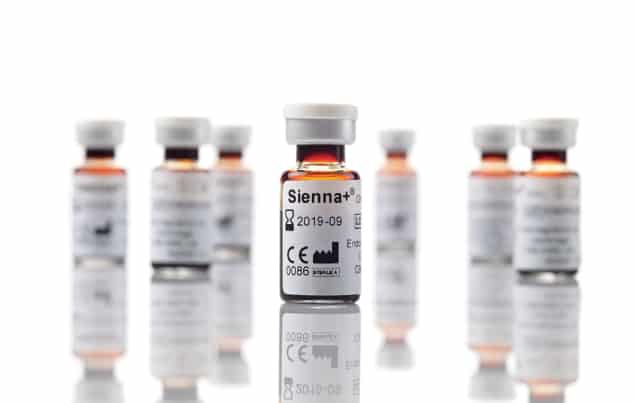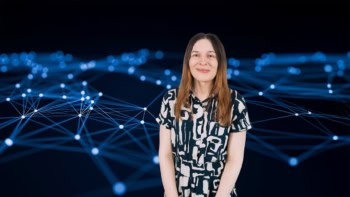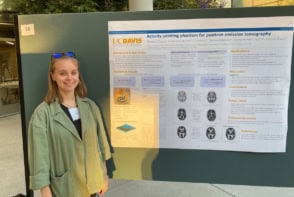Simon Hattersley is a co-founder of Endomagnetics, a Cambridge-based firm that makes magnetic nanoparticle systems for detecting cancer. Here, he explains how the company and its technology developed

How did Endomagnetics get started?
It came out of something called the Biomagnetometer Project, which was set up by Quentin Pankhurst at University College London (UCL). He was looking for applications of magnetic nanoparticles, and a surgeon, Michael Douek, told him that although everybody is terribly interested in new cancer drugs, he and his colleagues would also really like new tools to help them perform operations. One idea they discussed was to use magnetic material to track lymph flow from the area around a tumour through to the lymph nodes, so that surgeons could biopsy the right nodes and thus determine whether a cancer had spread. This information is critical to providing correct treatment for the patient, as over-treatment (unnecessary surgery and chemotherapy) can be almost as damaging as under-treatment. The existing techniques for doing this involved using a blue dye and a radioactive tracer that can be very difficult to obtain, and there’s also a lot of regulatory inconvenience associated with radioactivity. So there was clearly a possibility of using magnetic particles to do the localization instead, and Quentin managed to get a research grant to pursue this. That’s when I got involved.
What had your career been like up to then?
I worked for a very long time at a company called Sira, and I did all sorts of interesting things there: electronics, software, testing instrument systems, developing tools for automatically inspecting things like float glass, and so on. That was very good training for something like the Biomagnetometer Project, and my physics background was incredibly helpful as well because it means you’re up for taking on new challenges and analysing new things. So when Quentin came to Sira in 2004 looking for someone who could replace a researcher he had lost, I jumped at the opportunity.
At what point did the project become a company?
It was quite a long and difficult road. We celebrated a notional 10-year anniversary in May 2017, but the first board meeting didn’t happen until July 2009. The delay was partly because we were spinning out from UCL, and we had considerable issues with doing a deal on the intellectual property. At one point, we thought we had an agreement, but then the proposed deal was withdrawn. That left us in a situation where we really thought the company was going to die, because we couldn’t see how we were going to move forward.
How did you get out of that situation?
Two things happened. The first was that we managed to get a medical device manufacturing company, ITL, to apply to the Technology Strategy Board (now Innovate UK) for a grant to do collaborative development between researchers and industry on a new product. The other was that I worked out a better way of doing the underlying technology, one that was much more practical to commercialize. Our original system for detecting the magnetic nanoparticles was based on a superconducting quantum interference device (SQUID) sensor that operated in liquid nitrogen, and although we managed to cope with supplying liquid nitrogen to the operating theatres during the clinical trials, it was a hell of a nuisance. There were issues even with small things like taking nitrogen up and down in a lift – people get quite exercised about the possibility of spillages in small spaces. Also, SQUIDs are very sensitive to radiofrequency fields, and under certain circumstances they will become completely non-operative if there’s a sufficient level of background interference, however good your screening is – and we spent a long time trying to produce good screening.
On one occasion, the SQUID simply failed to tune in the operating theatre, and it was only after the operation was over (all the trials were done using both the radioactive technique and our magnetic technique) that we worked out that the radiofrequency interference was coming from one of the overhead lights. If I’d known that and I’d been able to turn off that one set of lights, we’d have been able to continue, but that lack of robustness in a system you’re hoping to market everywhere is just not going to be acceptable. Then there’s the fact that not many companies make SQUIDs that work at liquid-nitrogen temperatures – and of course, the low-temperature ones, which require liquid helium, were completely out of the question.
Eventually, I managed to work out a way of doing our measurements with room-temperature electronics by pushing up the frequency to increase the level of sensitivity, using really low-noise amplifiers and developing our correlation techniques a bit more. That realization – together with £400,000 in free money, essentially, from the Technology Strategy Board to do the collaborative venture with ITL – was absolutely key to bringing UCL Business back on board and completing a deal.
Who did you bring in to help get the company started?
In addition to Quentin and myself, we also have a third founder, Audrius Brazdeikis, who is a biomedical physicist at the University of Houston in Texas, US. He got involved as part of a London–Texas initiative for collaborative working in biosciences; he worked at the superconductivity centre in Houston, so the idea was that he would provide advice about the SQUID magnetometry and magnetic sensing. Subsequently, Audrius has produced many beautifully engineered prototype probes during the development process. During the research project, we got considerable support from Michael Douek in getting our equipment into the operating theatre. But when we moved beyond the research project and were trying to set the thing up as a company, we went through about three potential CEOs. The difficulties of completing a deal meant that various people got bored with the process and disappeared, or we decided they were no longer suitable.
It wasn’t until late 2010 that our current CEO, Eric Mayes, joined us. He arrived at quite a critical time, because while our focus had been largely on building a machine that was sensitive enough to detect magnetic nanoparticles, we soon learned there was a real problem with the nanoparticles themselves. We were using a material called Endorem, which is an intravenously-injected contrast agent for magnetic resonance imaging, but then other types of contrast agent, which are gadolinium-based and completely unsuitable for our purposes, essentially took over the market. This was a little bit of a blow, but it was also a very good opportunity, because Eric tracked down an alternative manufacturer of nanoparticles and got an agreement to supply the particles we needed to our specification. He also got a CE mark [European regulatory approval] for nanoparticles that could be injected into tissue. We’d been using the previous stuff “off-label”, so although we could tell surgeons “This is what you have to go out and buy”, we wouldn’t have been able to market it ourselves because it was an unofficial use. And when you do the sums, it becomes quite obvious that it’s the consumable product that makes money for you, not the instrument itself. It’s like printers and ink – you make money out of the ink, not out of selling the printers.

What’s the next step for the company?
Our magnetic nanoparticles have been used to treat more than 25,000 women so far, primarily in Europe, and Endomagnetics are in the process of obtaining approval from the US Food and Drug Administration (FDA). Getting approval for our product in Europe was actually not too bad, but the US process has been more lengthy because we needed to conduct a clinical trial of the products in the US first, and the pre-market approval process is more complex: the result was something like two crates full of paper that needed handling with a forklift. It would be a very big thing for Endomagnetics to get into the US, because it’s such a big share of the world market. Endomagnetics has also launched another product for marking breast tumours, and it is now on the market in Europe and the US. Most breast cancers are identified when they are only a few millimetres in size, which is good for the patient, but means that surgeons require some guidance to find and remove the cancer. The Magseed marker is placed in the tumour under radiological guidance before surgery and the surgeon uses Endomagnetics’ Sentimag probe to locate the marker and remove the tumour. The Magseed marker is in use at some of the top cancer hospitals in the US and featured on the BBC’s “Trust Me, I’m a Doctor” programme in January 2018.
What do you know now that you wish you’d known when you started?
I think I was a bit naïve about how the investment process works, particularly during the technology-transfer stage. The technology-transfer departments of universities are run as investment businesses. They are not the same as venture capitalists, but they are primarily interested in making money, so although they tend to promote themselves as being there to “help researchers commercialize their ideas” (and they do have that role), they can take an extremely hard-nosed attitude. It’s not nearly as straightforward as it is sometimes painted, and you can end up in a situation where you feel you are losing a massive amount of the company to the university. But there are so many things where you just have to live and learn.
Such as?
Well, Endomagnetics has actually gone extremely well in many ways. We’ve never had the dreaded “down round” – we’ve always been able to raise new investment at either the same share price or an increased share price, and that’s really quite important for the position of founders. My other company, Michelson Diagnostics, started off well, with some really cracking technology; the main product is a skin imaging system that can diagnose skin cancers without the need for a biopsy. But it’s never met the level of sales that it needed, and while prospects are now improving, the interim has been absolutely dire. Our larger investors completely lost patience with us: at one funding round they would only put in money on terms that essentially gave them the whole company. This means that the founders have ended up with next to nothing, and the early-stage smaller investors were completely wiped out. It’s a real shame that people who put in so much time, effort and intelligence into the development of something that is fundamentally good can essentially lose the lot. When we set the thing up I was thinking, “Well, it might fly or it might fail, but if it fails, so be it; we’ve given it our best shot.” What I wasn’t psychologically prepared for was that something in-between could happen, where the company keeps going but you’ve got no ownership or control of it anymore.
What led to that situation?
We didn’t realize how difficult it would be to sell our imaging technology to clinicians. It seems that in the field of dermatology, people are very, very conservative, and even with lots of research papers published to show how useful our system is, that doesn’t necessarily make people buy it. Apart from that, there’s the fact that developing medical devices and getting them to market is a long-winded process. Between the really complex technologies and the amount of regulatory stuff that’s involved, you can easily be talking 10 to 15 years from an initial idea through to actually making any money out of it. (Money is not the be-all and end-all, but it is some indication that you are actually getting the product out there.) That is far beyond the time horizons for a lot of investors: even assuming they come in when the idea has got a bit more sorted out, are they really going to want to wait perhaps eight to 10 more years before they’ve got any hope of getting their money back? The answer, probably, is “no”. That’s something particularly difficult with medical devices: finding investors who are prepared to go the distance with you. On a brighter note, Michelson Diagnostics is now selling a device that can image blood-vessel networks within the skin and is developing new applications in the treatment of burns and scars.
Do you have any advice for anyone thinking of starting a new firm in medical devices?
Talk to a lot of good people. It’s difficult to find the good people, but you can sniff them out eventually. There’s so much you need to know, frankly, so it’s very good to find some people who’ve been through it.



